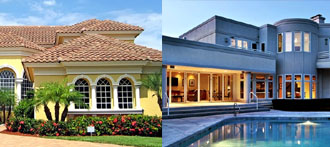Different Methods of Valuation
1) Land and Building Method for Bungalows / Flats.
a) Bungalows / Houses: In this case the cost of land and building are assessed separately and added to get the present value of the property
Valuation of Land to be considered
i) Guide lines from Registrar’s Department (Circle rates)
ii) Price paid within a reasonable time, in bonafied transactions of purchase of lands acquired.
iii) Demand, locality, characteristics like shape, size and location of Roads and Parks.
iv) Opinions of relevant person such as Neighbors, Brokers and recent sales and prevailing trend.
Valuation of Building to be considered
Plinth area rates bases on CPWD or State PWD and adjusted by Index cost,
Present Value of Building
Flats: The above method of Land and building method can not be applied on flats since G. House societies and DDA/ MCD Flats are effected by various factors like common passages, lifts, common places of assembly, parking. Mostly it depends on Social built up of the housing complex also. The rates are assessed from Per Square feet rate of the super area which includes Plinth area + common share of common areas such as Entrance, lifts, passages, stair hall and parking etc. It is generally taken as 15-20% higher than the plinth area. The valuation is done, thus on Prevailing rates of the super area in the locality.
Area are Defined as
1) Floor Area
2) Plinth Area
3) Super Area
We will discuss on this when we take up the Land/ Building/ Flat valuation in details.
2) Rental Capitalization Method: It consists of capitalizing the net annual Rental Income (NAR) at an appropriate rate of Interest and rate of Capitalization (80% as per Wealth Tax rules for Delhi / NCR) Net annual Rent income equals to Gross Rental Income – outgoings like Property tax, repairs, maintenance service charges, Insurance premiums, rent collection and management charges etc. app. 40%
3) Development Method: This method is used to evaluate such property where there is a developmental potential, so that value of property after development will be increased more than the expenditure incurred, for example large portion of land can be divided in small plots and developed fully so as to provide plots of land for residential societies, or a large complex of multistoried buildings, shopping / commercial complex etc. In such case the cost is decided per acre (4840 Sqyd). The cost can be arrived at by assessing the cut plot rates in the vicinity adjusted by the following facts :
A) Cost of Development which is 20% : It includes
i) Roads
ii) Gardens / Parks
iii) Underground drains
iv) Electric mains and sub station
v) Earth filling / cutting
vi) M.C taxes
vii) SewageB) Professional Charges to Architect Engineer
C) Cost of obtaining Vacant Possession from the existing occupant is required.
D) Developers Profit: 15-25%
This is a vast subject and shall be taken up separately.
4) Profit Method: This method is applicable to Hotels, Cinemas, PVRS, and Marriage Halls. This method as the name suggests deals in working the profit from the property subsequently capitalizing, the same at appropriate rate based on factors.
i) AV of Net Profit for last three years
ii) Good will of the Property
This is in general as to what the Profession of Valuation is and is required to be done dedicatedly and with honesty.
Property Valuation for
- Income Tax
- Capital Gain Tax
- Wealth Tax
- Dissolution of a Partnership
- Rent and Depreciation
- Jewellery
- Property Transfer
- Purchase, Sale, Takeovers and Mergers
- Credits
- Bank Guarantees
- Projecting the Right Image
- Rupee Devaluation / Revaluation
- Advance payment against works contract
- Incentives
- Security with Power Supply Companies
- Duty Draw-Back and Export Incentives
- Foreign Collaboration
- Technological Know-how
- Import Duty
- Octroi
- Auction
- Vacating Premises
- Machine Rent
- S.S.I. Registration
- Hidden Costs
- General Insurance and Insurance Cover
- Stamp Duty
- Acquisition by Government
- Liquidator’s Role
- Co-op. Society and Charitable Trusts
- Last Testaments and Wills
- Visas
- Executive Perks
- Housing Loans
- Division of Assets in the Family
- Divorce
- Larger Public Interests
Creative Ideas
 What is Valuation?
What is Valuation?
Before we go for different methods of Valuation, it is important to know as what value is... Read More Few words about us
Few words about us
We have a dynamic team of highly qualified (Engineers, MBA's) & experienced AutoCAD professionals... Read More Why Property Valuer.org
Why Property Valuer.org
We provide the Best and Qualitative Valuation Report in reasonable time period and at reasonable charge... Read More

